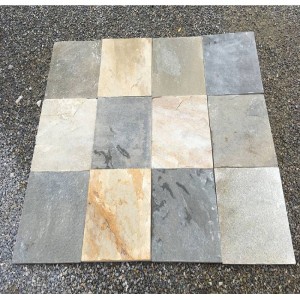
Stone floors are beautiful and unexpected, not to mention long-lasting. Aside from concrete, 石材地板 is perhaps the only flooring solution that works just as good outdoors as it does indoors. However, stone floors come with a hefty price tag that requires some thinking before making the final choice. If you’re new floors for your home, take these pros and cons of stone flooring into your decision-making process.
Natural stone flooring is a style of tile that’s cut directly from stone blocks. Natural stone comes from various mountain-born minerals, usually marble, granite, travertine, limestone, and sandstone, unlike artificial stone products.
On average, the total cost of stone flooring will range from $8 to $47 per square foot. However, the actual cost of a finished project will depend on the size of tiles, type of stones, complexity and the degree of subfloor preparation required to install.
The final cost of getting stone flooring will be significantly impacted by the type of stone that you choose.

Here’s an average estimate of how much popular stone floors cost:
Simple maintenance and care can extend the lifespan of your stone flooring and protect your investment. To properly care for stone floors, it’s important to know if your stone’s category belongs to siliceous or calcareous stone.
Once you know the category your stone floor tiles belong to, it’s easier to keep up with the daily cleaning procedures. Dust mop interior floors using a non-treated dry dust mop. Sand and dirt do the most damage to natural stone. Regular maintenance involves washing with neutral cleaners, preferably soapless cleaners, to minimize streaks. Liquid dishwashing soaps are acceptable.
As far as design options, stone flooring is somewhat limited compared to other flooring options like vinyl 或者 tile.
With stone flooring, your design options are limited to the type of stone you choose and the finish. The finish refers to the final look and feel of the stone’s surface. In most cases, it comes either polished, honed or tumbled, but it’s important to check out a stone flooring buying guide to compare the different materials and designs.
Natural stone with a polished finish has a glossy and reflective surface. This type of finish helps the color and pattern of the stone to appear more saturated. However, it will also show dust, smudges and wear more quickly than other finishes. Polished stone flooring can also be more slippery, especially when wet.
A honed finish gives a more natural appearance with a satin-smooth surface. Colors and patterns appear more earthy and less shiny. The honed finish is often used in bathrooms and kitchen floors because it gives more traction when wet.
Very similar to the honed finish, but tumbled natural stone leaves more of the stone’s natural texture. With this finish, the floor won’t be completely flat and smooth. Instead, the surface will have a more chiseled look.
This finish involves a hot torch flame to create a non-slip finish with a semi-rough surface. A flamed stone finish is more likely to be used outdoors or in any room that needs a less slippery surface.
Some stones can be brushed with wire wheels and brushes to obtain a brushed finish. The result is a smooth-to-the-touch stone that looks casually worn—ideal for anyone who wants to achieve a more old-fashioned look.
The longevity of natural stone flooring is far superior to any other style of flooring in the market. This is why we still see stone floors from hundreds of years ago. On average, the lifespan of natural stones, like marble and granite, can be well over 100 years. That’s compared to ceramic tile with a life expectancy of 75 years.
Stone tiles aren’t uniform and take moderate skills to lay evenly. Installation of stone flooring can take three days, depending on the area size and the installation team. It’s recommended to use a professional. Stone flooring isn’t for the DIYer as it’s labor-intensive and requires extreme precision.
Most installations will occur in areas where tile, carpet, wood or other floorings already exist. So, the first step will be removing your old flooring. The next step in the installation process is to ensure the subfloor is prepped. Depending on the type of subfloor you have, your contractor will need to install a backer board or raise the height of your flooring to make it even. Once the subfloor is ready, the crew will begin to lay the stone tile. After the tiles are laid out, they’ll apply the grout and set the tiles in place.
In most cases, you’ll have to wait about 48 hours after the tiles are laid to walk freely around the house to give enough time for the grout to dry.
As a natural product, stone floors don’t lend themselves to brand identity. The best way to find high-quality stone tiles is to find a reputable, experienced tile dealer and work with them to help you find the best materials for your project.
It’s easy to see why everyone loves the look and feel of natural stone flooring. Stone exudes a high-end luxurious style that can withstand the test of time and durability, far outlasting carpet, wood and tile flooring options. If you are considering investing in getting stone floors for your home, keep these pros and cons in mind and make sure to work with a reputable tile dealer in your area.